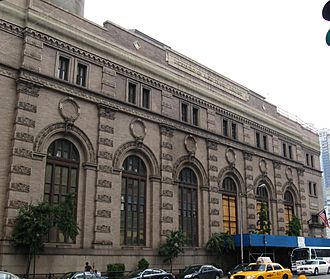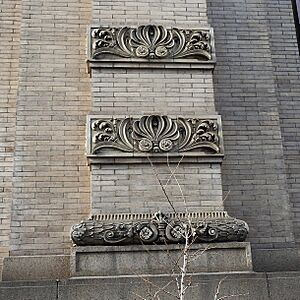IRT Powerhouse facts for kids
Quick facts for kids IRT Powerhouse |
|
|---|---|

Facade of the powerhouse on Eleventh Avenue
|
|
| General information | |
| Type | Steam power plant |
| Architectural style | Renaissance Revival |
| Address | 855–869 Eleventh Avenue |
| Town or city | New York City |
| Country | United States |
| Coordinates | 40°46′19″N 73°59′32″W / 40.77194°N 73.99222°W |
| Construction started | 1902 |
| Completed | 1905 |
| Opened | October 27, 1904 |
| Owner | Consolidated Edison |
| Dimensions | |
| Other dimensions | 500 feet (150 m) (smokestack) |
| Technical details | |
| Structural system | Steel frame |
| Floor count | 5 |
| Design and construction | |
| Architect | Stanford White |
| Developer | Interborough Rapid Transit Company |
| Engineer | John van Vleck, Lewis B. Stillwell, and S. L. F. Deyo |
| Designated | December 5, 2017 |
| Reference no. | 2374 |
The IRT Powerhouse is a historic building in New York City. It used to be a huge power station for the Interborough Rapid Transit Company (IRT). This company operated part of what is now the New York City Subway.
The building is located in the Hell's Kitchen and Riverside South areas of Manhattan. It takes up a whole city block between 58th Street, 59th Street, Eleventh Avenue, and Twelfth Avenue.
Famous architect Stanford White designed the IRT Powerhouse. He wanted it to be a grand, beautiful building. It was built to supply electricity to the subway's first line. At its busiest, it could create over 100,000 horsepower (75,000 kW) of power!
Construction happened from 1902 to 1905. The powerhouse opened on October 27, 1904. Over the years, it was updated and expanded. In 1959, Consolidated Edison (Con Ed) bought the building. They changed it to be part of New York City's steam system. In 2017, the building was officially named a city landmark.
Contents
Location and Size
The IRT Powerhouse is on the West Side of Manhattan in New York City. It sits right on the edge of the Hell's Kitchen and Riverside South neighborhoods.
The building has addresses on Eleventh Avenue, West 58th Street, and West 59th Street. It fills the entire block. This block is bordered by 59th Street to the north and 58th Street to the south. Eleventh Avenue is to the east, and Twelfth Avenue and the Hudson River are to the west. The block is about 200 by 800 feet (61 by 244 m) in size.
When it first opened, the powerhouse was 200 feet (61 m) long along Eleventh Avenue. It stretched 694 feet (212 m) westward. Its location was perfect because it needed easy ways to get coal and lots of water for its boilers.
Building Design
The IRT Powerhouse is a very detailed building. It was designed in the Renaissance Revival style by Stanford White. He was a main architect at the firm McKim, Mead & White. The inside parts were designed by engineers John van Vleck, Lewis B. Stillwell, and S. L. F. Deyo.
The subway company wanted the building to look grand and impressive. They wanted it to be a major landmark, like Grand Central Terminal. This shows the ideas of the City Beautiful movement, which aimed to make cities more beautiful.
The powerhouse was built in two main parts. The boiler room was on the south side, facing 58th Street. This is where the steam was made. The engine and generator room was on the north side, facing 59th Street. This is where the electricity was created.
The roof of the powerhouse is 125 feet (38 m) above its basement. It has several smaller sloped roofs. When it first opened, there were five tall brick smokestacks. They looked like the chimneys on big steamships nearby. These original smokestacks have all been removed. A seventh smokestack was built in 1967 and is still there today.
Building Exterior
The outside of the powerhouse is made of granite, brick, and terracotta. It has many decorative details. The bottom part of the building is covered with granite. The upper parts are made of brick and terracotta.
The building has many tall, arched windows. These windows have fancy decorations above them. There are also horizontal decorative bands running across the building. The overall look of the building was inspired by the Boston Public Library.
The most decorated part is the side facing Eleventh Avenue. This side has eight sections, called bays. The middle six bays stick out a little. They are framed by brick and terracotta columns called pilasters. These pilasters have flower-like designs called palmettes. The main entrance is on this side, with a classic-looking doorway.
The sides facing 58th Street and 59th Street are similar. They are both nineteen bays wide. These sides also have many arched windows. Some openings at the bottom have metal gates. These were once used for New York Central Railroad freight trains.
Building Structure
The building has a strong steel frame inside. This frame weighs about 12,000 short tons (11,000 long tons; 11,000 t). The floors and coal storage areas are made of strong steel beams. The steel was so strong it was like what you would use for bridges.
The floors themselves are made of concrete. They are reinforced with metal to make them extra strong. The floors were designed to hold very heavy loads. The main floor in the engine room is about 8 feet (2.4 m) higher than the boiler room floor.
The building's foundation was built in different ways. This was because the ground underneath was not level. Some parts of the foundation rest on concrete blocks. Other parts have massive granite bases. These bases support the huge engines.
Powerhouse Equipment
The IRT Powerhouse was designed like other large power plants of its time. The boiler room and the engine room were separated by a thick brick wall. This wall would stop steam from spreading if a pipe broke.
When it was built, the IRT Powerhouse was meant to be the biggest power station in the world. It had special cranes to move heavy equipment.
Boilers and Coal
The powerhouse had a smart design for its boilers. It was divided into six separate sections. Each section had two rows of six boilers. These boilers fed steam to two engines in the next room. This design allowed the plant to be very flexible.
The powerhouse used 1,000 short tons (890 long tons; 910 t) of coal every day. This coal created 132,000 horsepower (98,000 kW) of power. Coal arrived by boat at a pier on Twelfth Avenue. It was then moved by conveyor belts into the building.
The coal was stored in seven large bunkers above the boilers. A system of conveyors moved the coal from the bunkers to any of the boilers. This allowed them to use different types of coal. For example, high-quality coal could be used during busy times. After the coal was burned, the ashes fell into hoppers. These ashes were then taken away by train or barge.
Engines and Generators
The steam from the boilers went to large steam engines. Each engine was very powerful, at 12,000 horsepower (8,900 kW). These engines then powered the generators.
The generators created electricity. There were nine large generators, each making 5,000 kilowatts (6,700 hp) of power. They spun at 75 rotations per minute. These generators produced 3-phase, 25-cycle, 11,000 volt alternating current.
This electricity traveled from the generators to switchboards. From there, it was sent to eight smaller substations around Manhattan and the Bronx. These substations changed the alternating current to 600 volts of direct current. This direct current then powered the third rail system for the subway trains.
There were also four smaller turbo generators. These produced light for the subway stations. In total, the generators could produce 100,000 horsepower (75,000 kW).
History of the Powerhouse
Plans for New York City's first subway line began in 1894. The Rapid Transit Subway Construction Company (RTSCC) was chosen to build and operate the subway. They signed a contract in 1900. The Interborough Rapid Transit Company (IRT) was formed in 1902 to run the subway.
Building the Powerhouse
The RTSCC needed to build a power station for the subway. It had to be powered by steam. This meant it needed to be near water for the boilers. It also needed easy access for coal delivery.
In late 1901, the company bought the land for the powerhouse. It cost $900,000. Stanford White was hired as the architect. He drew up plans for the building's outside in 1902.
The building was first planned to be made of concrete. But the IRT decided to use brick in March 1902. This was after bricklayers threatened to go on strike. The powerhouse was also made longer than first planned. This was because the subway system was expanding.
Construction moved quickly. But there were some strikes that caused delays. The powerhouse was mostly finished by April 1904.
Powering the Subway
The IRT's 59th Street powerhouse opened on October 27, 1904. This was the same day the first subway line opened. Stanford White, the architect, sadly died in 1906.
Soon after opening, the IRT set up a lab at the coal dock. They tested the coal to make sure it was good quality. This helped the plant run more efficiently.
The IRT subway system grew very fast. By 1907, the powerhouse needed more power. They added more equipment to the boilers. Between 1909 and 1910, they installed five new turbo-generators. These added 15,000 kilowatts (20,000 hp) of power. More upgrades happened between 1913 and 1917. In 1917, they added three very powerful turbo-generators.
In 1940, the New York City Board of Transportation (BOT) took over the IRT. This meant the 59th Street power station became part of the city's subway system. By this time, some of the equipment was old. In 1946, the board decided to make the plant bigger. An annex was completed in 1950. This new part added 62,500 kilowatts (83,800 hp) of power. It used a single, more efficient boiler. In 1951, the New York City Transit Authority (NYCTA) took over the plant.
Selling the Powerhouse
By the mid-1950s, the old equipment was causing a lot of pollution. Some parts of the plant had never been replaced. A report in 1954 called the plant "an engineering museum piece."
The NYCTA wanted to sell the power plants. Mayor Robert F. Wagner Jr. suggested that Consolidated Edison (Con Ed) buy them. After some discussions, Con Ed bought the three plants in May 1959. They were the only company to bid at the auction. This sale helped the NYCTA buy more subway cars.
Recent Years
After buying the plants, Con Ed started to modernize them. The 59th Street plant was completely updated. It became a plant for the New York City steam system. In 1960, Con Ed installed modern high-pressure boilers.
In 1966, they installed two new boilers and a turbo-generator. They also replaced the four western chimneys with a single, very tall 500 feet (150 m) smokestack. By 1968, the plant was only using oil and gas for fuel.
People started trying to get the IRT Powerhouse named a city landmark in 1979. Historians supported it, but Con Edison was against it. They argued that the building had been changed a lot. The New York City Landmarks Preservation Commission (LPC) held more hearings in 1990 and 2009. Each time, Con Edison objected, and the building was not named a landmark.
However, the issue came up again in 2015. The LPC decided to prioritize the powerhouse for landmark status. Even though Con Edison still objected, the LPC worked with them. Finally, the IRT Powerhouse was officially named a city landmark on December 5, 2017. The next month, the LPC approved a plan to restore the old powerhouse.



